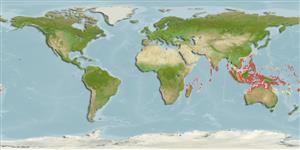Classification / Names
ชื่อสามัญ | ชื่อพ้อง | Catalog of Fishes(สกุล, ชนิด) | ITIS | CoL | WoRMS | Cloffa
>
Gobiiformes (Gobies) >
Gobiidae (Gobies) > Gobiinae
Etymology: Trimma: Greek, trimma, -atos = something crushed (Ref. 45335).
More on author: Herre.
Environment: milieu / climate zone / depth range / distribution range
นิเวศวิทยา
เกี่ยวกับทะเล,น้ำเค็ม เกี่ยวกับหินโสโครก; ระดับความลึก 20 - 30 m (Ref. 9360). Tropical
Indo-West Pacific: Philippines to Australia (Ref. 2334). Reported from Maldives (Ref. 11303).
ขนาด / น้ำหนัก / Age
Maturity: Lm ? range ? - ? cm
Max length : 3.0 cm TL เพศผู้/กระเทย; (Ref. 2334)
เงี่ยงครีบหลัง (รวม): 6 - 7; ก้านครีบอ่อนที่หาง (รวม): 9; เงี่ยงครีบก้น 1; ก้านครีบอ่อนที่ก้น: 8. Characterized by purplish body color with six red-orange stripe on head and anterior body; second dorsal spine usually elongate and filamentous; fifth pelvic ray branched, 60-70% length of fourth ray; longitudinal scale series 26-27; predorsal scales absent; cheek and opercle without scales; depth of body about 4.0 in SL (Ref. 90102).
Solitary or in small groups (Ref. 90102). Usually lives in caves and crevices of outer reef slopes (Ref. 2334). Inhabits deep lagoon and protected seaward reefs (Ref. 37816).
Life cycle and mating behavior
วัยเจริญพันธุ์ | การสืบพันธุ์ | การวางไข่ | เซลสืบพันธ์ของเพศเมีย(ไข่) | ความดกของไข่ | ตัวอ่อน
Randall, J.E., G.R. Allen and R.C. Steene, 1990. Fishes of the Great Barrier Reef and Coral Sea. University of Hawaii Press, Honolulu, Hawaii. 506 p. (Ref. 2334)
IUCN Red List Status (Ref. 130435)
Threat to humans
Harmless
Human uses
สถานที่แสดงสัตว์และพืชน้ำ: การค้า
ข้อมูลเพิ่มเติม
ชื่อสามัญชื่อพ้องกลไกการเผาผลาญพลังงานผู้ล่าการศึกษาเกี่ยวกับผลกระทบของสารประกอบทางเคมีที่เป็นอันตรายต่อสิ่งมีชีวิต ประชากร และสิ่งแวดล้อมการสืบพันธุ์วัยเจริญพันธุ์การวางไข่การรวมกลุ่มวางไข่ความดกของไข่เซลสืบพันธ์ของเพศเมีย(ไข่)Egg development
อ้างอิงการเพาะเลี้ยงสัตว์น้ำประวัติการเพาะเลี้ยงสัตว์น้ำสายพันธุ์พันธุศาสตร์ElectrophoresesอัตราพันธุกรรมโรคการแปรรูปNutrientsMass conversion
เครื่องมือ
Special reports
Download XML
แหล่งที่มาจากอินเตอร์เน็ต
Estimates based on models
Preferred temperature (Ref.
123201): 26.4 - 28.5, mean 27.8 °C (based on 58 cells).
Phylogenetic diversity index (Ref.
82804): PD
50 = 0.5000 [Uniqueness, from 0.5 = low to 2.0 = high].
Bayesian length-weight: a=0.01023 (0.00477 - 0.02194), b=3.02 (2.84 - 3.20), in cm total length, based on LWR estimates for this (Sub)family-body shape (Ref.
93245).
ความสามารถในการกลับคืนสู่ปกติ (Ref.
120179): ความสูง, เวลาต่ำสุดที่จะทำให้ประชากรเพิ่มขึ้นเป็น 2 เท่าใช้เวลาน้อยกว่า 15 เดือน (Preliminary K or Fecundity.).
Fishing Vulnerability (Ref.
59153): Low vulnerability (10 of 100).
Nutrients (Ref.
124155): Calcium = 339 [155, 981] mg/100g; Iron = 1.65 [0.75, 3.40] mg/100g; Protein = 18.2 [16.1, 20.0] %; Omega3 = 0.17 [0.06, 0.44] g/100g; Selenium = 31.5 [11.1, 78.9] μg/100g; VitaminA = 104 [24, 441] μg/100g; Zinc = 3.86 [2.21, 6.17] mg/100g (wet weight);
